IMAT5262: Research Ethics and Professional Issues in Computing Report
VerifiedAdded on 2021/05/31
|16
|4181
|103
Report
AI Summary
This report, prepared for IMAT5262, delves into the critical aspects of research ethics and professionalism within the computing field. It begins by highlighting the increasing importance of ethical considerations in technology, emphasizing the need for a code of professional ethics. The report explores various responsibilities of computing professionals, including those to clients, employers, other professionals, and the public, while also examining ethical issues such as computer crime, hacking, and privacy concerns. A literature review provides a historical context, tracing the evolution of ethical issues in computing and analyzing current situations. The methodology section outlines the approaches used, including questionnaires, interviews, and case studies. The report concludes by synthesizing the findings, offering insights into the complex interplay of ethics and professionalism in the rapidly evolving world of computing, along with a detailed project plan and reference list.
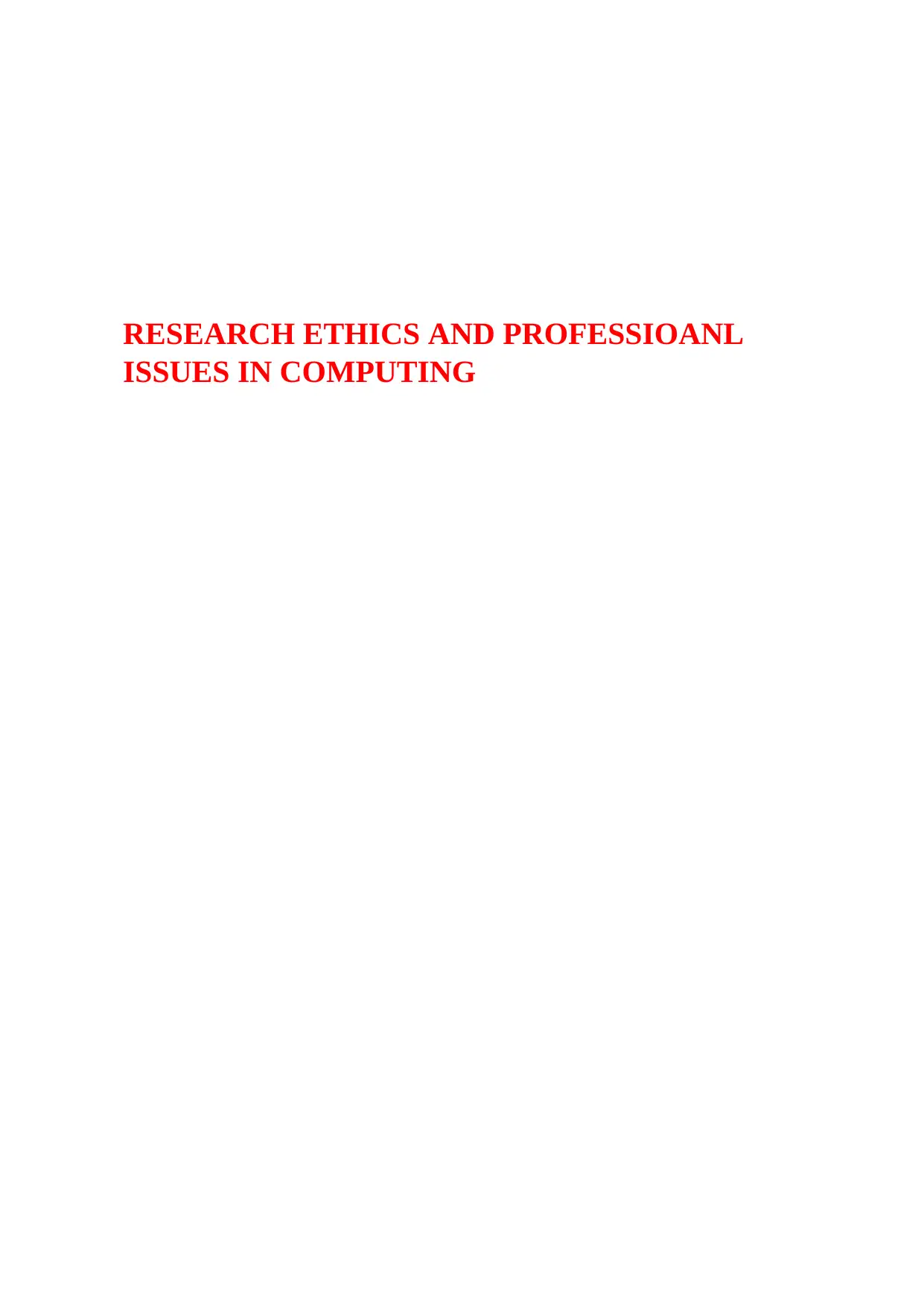
RESEARCH ETHICS AND PROFESSIOANL
ISSUES IN COMPUTING
ISSUES IN COMPUTING
Paraphrase This Document
Need a fresh take? Get an instant paraphrase of this document with our AI Paraphraser
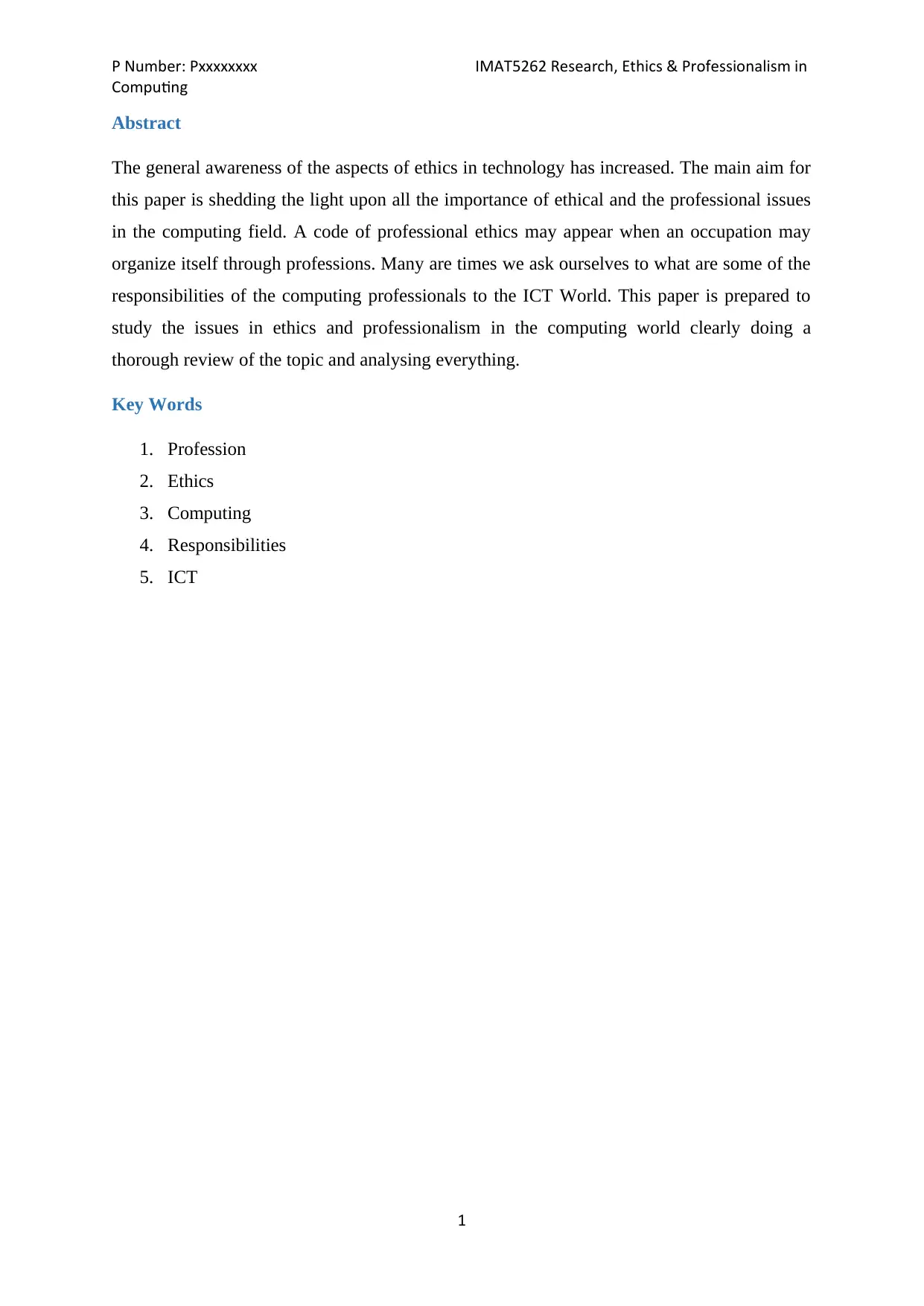
P Number: Pxxxxxxxx IMAT5262 Research, Ethics & Professionalism in
Computing
Abstract
The general awareness of the aspects of ethics in technology has increased. The main aim for
this paper is shedding the light upon all the importance of ethical and the professional issues
in the computing field. A code of professional ethics may appear when an occupation may
organize itself through professions. Many are times we ask ourselves to what are some of the
responsibilities of the computing professionals to the ICT World. This paper is prepared to
study the issues in ethics and professionalism in the computing world clearly doing a
thorough review of the topic and analysing everything.
Key Words
1. Profession
2. Ethics
3. Computing
4. Responsibilities
5. ICT
1
Computing
Abstract
The general awareness of the aspects of ethics in technology has increased. The main aim for
this paper is shedding the light upon all the importance of ethical and the professional issues
in the computing field. A code of professional ethics may appear when an occupation may
organize itself through professions. Many are times we ask ourselves to what are some of the
responsibilities of the computing professionals to the ICT World. This paper is prepared to
study the issues in ethics and professionalism in the computing world clearly doing a
thorough review of the topic and analysing everything.
Key Words
1. Profession
2. Ethics
3. Computing
4. Responsibilities
5. ICT
1

P Number: Pxxxxxxxx IMAT5262 Research, Ethics & Professionalism in
Computing
Contents
1. Background..................................................................................................................................3
2. Research questions......................................................................................................................4
3. Literature Review........................................................................................................................4
Introduction.......................................................................................................................................4
Causal Responsibility........................................................................................................................5
Role Responsibility...........................................................................................................................5
Legal Responsibility..........................................................................................................................5
Moral Responsibility.........................................................................................................................5
Past Development and history of ethical issues of professionals in computing................................6
Current situations and Responsibilities of Computing Professionals.................................................6
Responsibilities to clients and Users..............................................................................................6
Responsibilities to Employers.......................................................................................................7
Responsibilities to other Professionals...........................................................................................7
Responsibilities to the Public.........................................................................................................7
Ethical Issues in computing...............................................................................................................7
Computer Crime............................................................................................................................7
Hacking.........................................................................................................................................8
Privacy Issues................................................................................................................................8
Knowledge of Gap of research Ethics................................................................................................8
4. Methodology Review...................................................................................................................8
Introduction.......................................................................................................................................8
Methods.............................................................................................................................................9
Questionnaire.....................................................................................................................................9
Interviews........................................................................................................................................10
Online Surveys................................................................................................................................10
Skype...............................................................................................................................................10
Case Study.......................................................................................................................................10
Analysis Methods............................................................................................................................10
Thematic Synthesis......................................................................................................................10
Textual Narrative Synthesis Methods..........................................................................................10
Selection..........................................................................................................................................11
5. Conclusion..................................................................................................................................11
6. References..................................................................................................................................11
References List....................................................................................................................................11
2
Computing
Contents
1. Background..................................................................................................................................3
2. Research questions......................................................................................................................4
3. Literature Review........................................................................................................................4
Introduction.......................................................................................................................................4
Causal Responsibility........................................................................................................................5
Role Responsibility...........................................................................................................................5
Legal Responsibility..........................................................................................................................5
Moral Responsibility.........................................................................................................................5
Past Development and history of ethical issues of professionals in computing................................6
Current situations and Responsibilities of Computing Professionals.................................................6
Responsibilities to clients and Users..............................................................................................6
Responsibilities to Employers.......................................................................................................7
Responsibilities to other Professionals...........................................................................................7
Responsibilities to the Public.........................................................................................................7
Ethical Issues in computing...............................................................................................................7
Computer Crime............................................................................................................................7
Hacking.........................................................................................................................................8
Privacy Issues................................................................................................................................8
Knowledge of Gap of research Ethics................................................................................................8
4. Methodology Review...................................................................................................................8
Introduction.......................................................................................................................................8
Methods.............................................................................................................................................9
Questionnaire.....................................................................................................................................9
Interviews........................................................................................................................................10
Online Surveys................................................................................................................................10
Skype...............................................................................................................................................10
Case Study.......................................................................................................................................10
Analysis Methods............................................................................................................................10
Thematic Synthesis......................................................................................................................10
Textual Narrative Synthesis Methods..........................................................................................10
Selection..........................................................................................................................................11
5. Conclusion..................................................................................................................................11
6. References..................................................................................................................................11
References List....................................................................................................................................11
2
⊘ This is a preview!⊘
Do you want full access?
Subscribe today to unlock all pages.

Trusted by 1+ million students worldwide
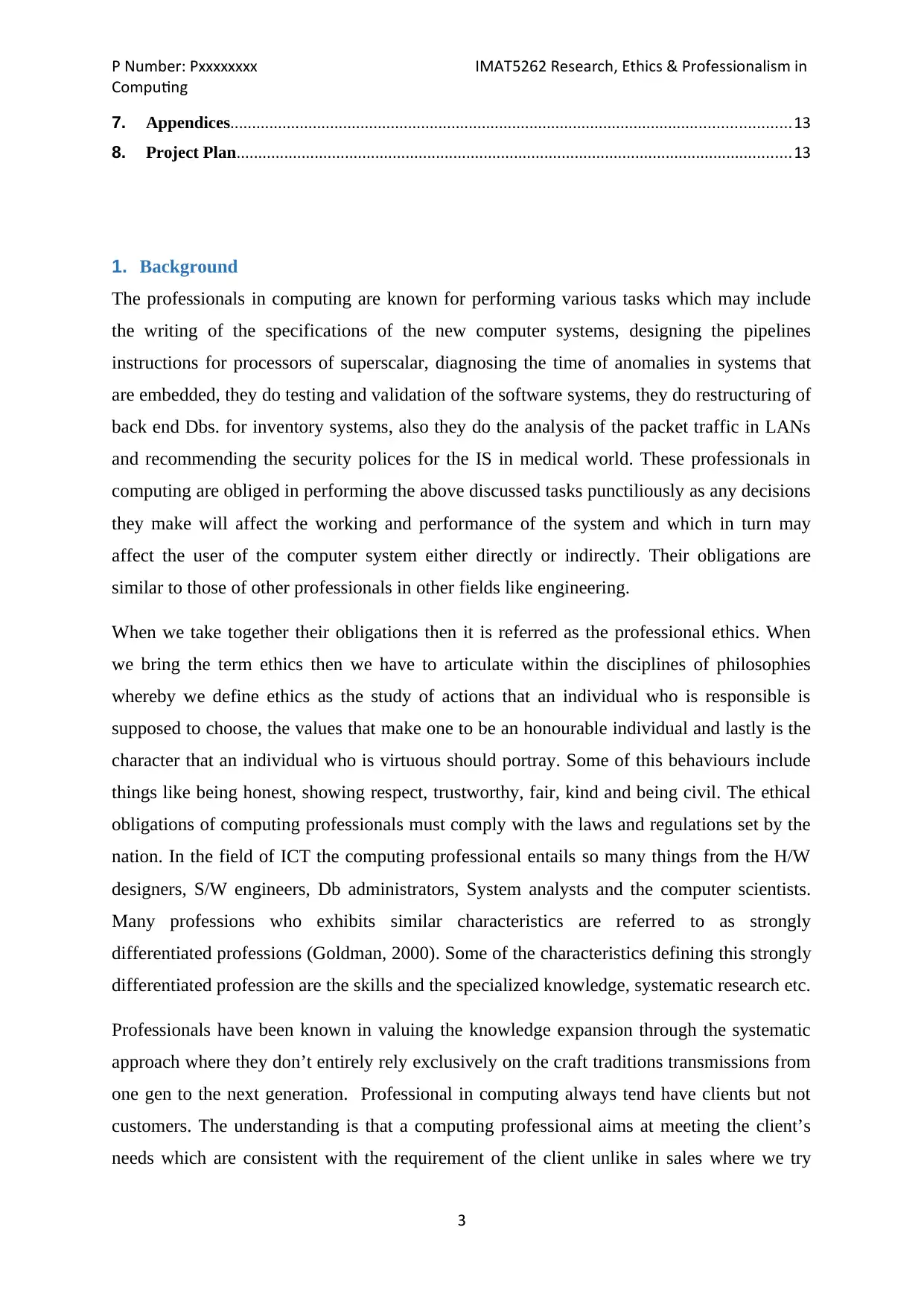
P Number: Pxxxxxxxx IMAT5262 Research, Ethics & Professionalism in
Computing
7. Appendices.................................................................................................................................13
8. Project Plan................................................................................................................................13
1. Background
The professionals in computing are known for performing various tasks which may include
the writing of the specifications of the new computer systems, designing the pipelines
instructions for processors of superscalar, diagnosing the time of anomalies in systems that
are embedded, they do testing and validation of the software systems, they do restructuring of
back end Dbs. for inventory systems, also they do the analysis of the packet traffic in LANs
and recommending the security polices for the IS in medical world. These professionals in
computing are obliged in performing the above discussed tasks punctiliously as any decisions
they make will affect the working and performance of the system and which in turn may
affect the user of the computer system either directly or indirectly. Their obligations are
similar to those of other professionals in other fields like engineering.
When we take together their obligations then it is referred as the professional ethics. When
we bring the term ethics then we have to articulate within the disciplines of philosophies
whereby we define ethics as the study of actions that an individual who is responsible is
supposed to choose, the values that make one to be an honourable individual and lastly is the
character that an individual who is virtuous should portray. Some of this behaviours include
things like being honest, showing respect, trustworthy, fair, kind and being civil. The ethical
obligations of computing professionals must comply with the laws and regulations set by the
nation. In the field of ICT the computing professional entails so many things from the H/W
designers, S/W engineers, Db administrators, System analysts and the computer scientists.
Many professions who exhibits similar characteristics are referred to as strongly
differentiated professions (Goldman, 2000). Some of the characteristics defining this strongly
differentiated profession are the skills and the specialized knowledge, systematic research etc.
Professionals have been known in valuing the knowledge expansion through the systematic
approach where they don’t entirely rely exclusively on the craft traditions transmissions from
one gen to the next generation. Professional in computing always tend have clients but not
customers. The understanding is that a computing professional aims at meeting the client’s
needs which are consistent with the requirement of the client unlike in sales where we try
3
Computing
7. Appendices.................................................................................................................................13
8. Project Plan................................................................................................................................13
1. Background
The professionals in computing are known for performing various tasks which may include
the writing of the specifications of the new computer systems, designing the pipelines
instructions for processors of superscalar, diagnosing the time of anomalies in systems that
are embedded, they do testing and validation of the software systems, they do restructuring of
back end Dbs. for inventory systems, also they do the analysis of the packet traffic in LANs
and recommending the security polices for the IS in medical world. These professionals in
computing are obliged in performing the above discussed tasks punctiliously as any decisions
they make will affect the working and performance of the system and which in turn may
affect the user of the computer system either directly or indirectly. Their obligations are
similar to those of other professionals in other fields like engineering.
When we take together their obligations then it is referred as the professional ethics. When
we bring the term ethics then we have to articulate within the disciplines of philosophies
whereby we define ethics as the study of actions that an individual who is responsible is
supposed to choose, the values that make one to be an honourable individual and lastly is the
character that an individual who is virtuous should portray. Some of this behaviours include
things like being honest, showing respect, trustworthy, fair, kind and being civil. The ethical
obligations of computing professionals must comply with the laws and regulations set by the
nation. In the field of ICT the computing professional entails so many things from the H/W
designers, S/W engineers, Db administrators, System analysts and the computer scientists.
Many professions who exhibits similar characteristics are referred to as strongly
differentiated professions (Goldman, 2000). Some of the characteristics defining this strongly
differentiated profession are the skills and the specialized knowledge, systematic research etc.
Professionals have been known in valuing the knowledge expansion through the systematic
approach where they don’t entirely rely exclusively on the craft traditions transmissions from
one gen to the next generation. Professional in computing always tend have clients but not
customers. The understanding is that a computing professional aims at meeting the client’s
needs which are consistent with the requirement of the client unlike in sales where we try
3
Paraphrase This Document
Need a fresh take? Get an instant paraphrase of this document with our AI Paraphraser
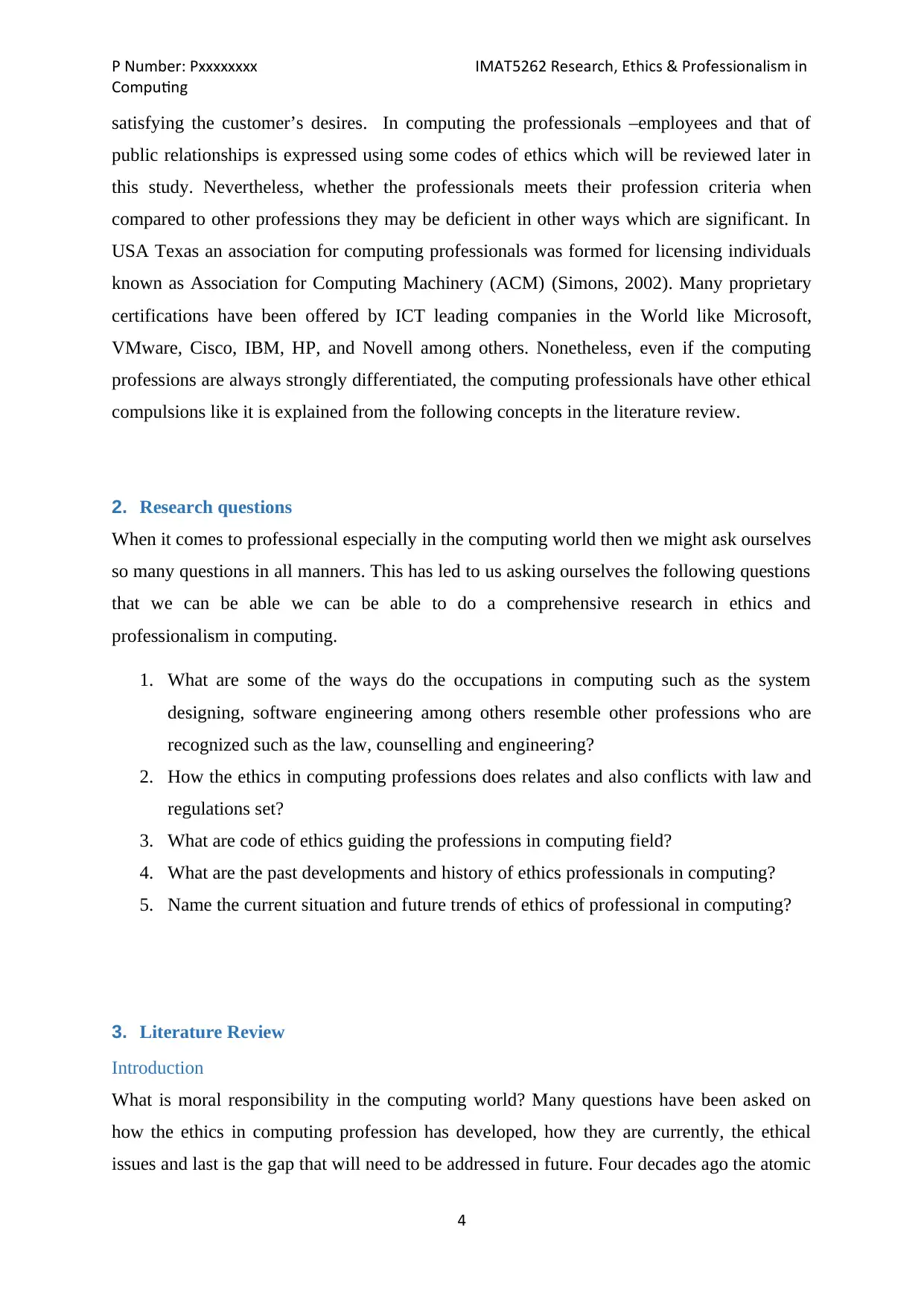
P Number: Pxxxxxxxx IMAT5262 Research, Ethics & Professionalism in
Computing
satisfying the customer’s desires. In computing the professionals –employees and that of
public relationships is expressed using some codes of ethics which will be reviewed later in
this study. Nevertheless, whether the professionals meets their profession criteria when
compared to other professions they may be deficient in other ways which are significant. In
USA Texas an association for computing professionals was formed for licensing individuals
known as Association for Computing Machinery (ACM) (Simons, 2002). Many proprietary
certifications have been offered by ICT leading companies in the World like Microsoft,
VMware, Cisco, IBM, HP, and Novell among others. Nonetheless, even if the computing
professions are always strongly differentiated, the computing professionals have other ethical
compulsions like it is explained from the following concepts in the literature review.
2. Research questions
When it comes to professional especially in the computing world then we might ask ourselves
so many questions in all manners. This has led to us asking ourselves the following questions
that we can be able we can be able to do a comprehensive research in ethics and
professionalism in computing.
1. What are some of the ways do the occupations in computing such as the system
designing, software engineering among others resemble other professions who are
recognized such as the law, counselling and engineering?
2. How the ethics in computing professions does relates and also conflicts with law and
regulations set?
3. What are code of ethics guiding the professions in computing field?
4. What are the past developments and history of ethics professionals in computing?
5. Name the current situation and future trends of ethics of professional in computing?
3. Literature Review
Introduction
What is moral responsibility in the computing world? Many questions have been asked on
how the ethics in computing profession has developed, how they are currently, the ethical
issues and last is the gap that will need to be addressed in future. Four decades ago the atomic
4
Computing
satisfying the customer’s desires. In computing the professionals –employees and that of
public relationships is expressed using some codes of ethics which will be reviewed later in
this study. Nevertheless, whether the professionals meets their profession criteria when
compared to other professions they may be deficient in other ways which are significant. In
USA Texas an association for computing professionals was formed for licensing individuals
known as Association for Computing Machinery (ACM) (Simons, 2002). Many proprietary
certifications have been offered by ICT leading companies in the World like Microsoft,
VMware, Cisco, IBM, HP, and Novell among others. Nonetheless, even if the computing
professions are always strongly differentiated, the computing professionals have other ethical
compulsions like it is explained from the following concepts in the literature review.
2. Research questions
When it comes to professional especially in the computing world then we might ask ourselves
so many questions in all manners. This has led to us asking ourselves the following questions
that we can be able we can be able to do a comprehensive research in ethics and
professionalism in computing.
1. What are some of the ways do the occupations in computing such as the system
designing, software engineering among others resemble other professions who are
recognized such as the law, counselling and engineering?
2. How the ethics in computing professions does relates and also conflicts with law and
regulations set?
3. What are code of ethics guiding the professions in computing field?
4. What are the past developments and history of ethics professionals in computing?
5. Name the current situation and future trends of ethics of professional in computing?
3. Literature Review
Introduction
What is moral responsibility in the computing world? Many questions have been asked on
how the ethics in computing profession has developed, how they are currently, the ethical
issues and last is the gap that will need to be addressed in future. Four decades ago the atomic
4

P Number: Pxxxxxxxx IMAT5262 Research, Ethics & Professionalism in
Computing
energy of Canada limited (AECL) which was known for manufacturing and selling cancer
radiations treatment which were known as Therac 25 which relied entirely on the computer
software in controlling its operations. In 1985 the Therac 25 caused the deaths of about 3
patients and seriously injuring other three patients to point it was hard for them to recover
immediately (N. G. Leveson and C. S. Turner, 1993). We might ask ourselves so many
questions to who was to blame: was it the operator administering the treatment? Was it the
developer who tested the control software’s? Was it the system engineer who forgot
something? Was it the manufacturer (AECL)? Was it the government agencies (Ladd, 1982)?
The scenario here can be used in analysing the different kinds of responsibility (H.
Nissenbaum, 1994).
Causal Responsibility
Responsibilities is attributed to the causes. If we consider the case of the tornado we may say
that it was responsible in for the house damage. In the scenario of Therac 25 treatment we
may say that the operator was the cause of the deaths for starting the radiations but we cannot
blame him/her just like we cannot blame the weather for failing morally.
Role Responsibility
The person who is assigned a task or a job or a function is the one who becomes responsible
for that specific role. In the Therac-25 case or scenario we consider the software developer to
be responsible for designing the software while the system engineer is designing of the
hardware machine.
Legal Responsibility
An organization or an individual will liable and legally responsible for the occurrence of such
problems that violates the stated law. In this, one can be charged for committing a crime or a
company be sued and charged for violating laws. In consideration of the Therac-25 scenario
the AECL could have been sued.
Moral Responsibility
The causal and legal responsibilities always tend to be so exclusive where in one case if one
is responsible then the other is not responsible. This kind of responsibility is so shared in the
manner that the professionals are always responsible for the products safety they are
designing. Moral responsibility is unique in that one can hold both the acting and failing to
act. A scenario case is where a hardware engineer notices there is flaw in the design and
could lead to damage or shock in the topology. Even if that is not his task the engineer of the
5
Computing
energy of Canada limited (AECL) which was known for manufacturing and selling cancer
radiations treatment which were known as Therac 25 which relied entirely on the computer
software in controlling its operations. In 1985 the Therac 25 caused the deaths of about 3
patients and seriously injuring other three patients to point it was hard for them to recover
immediately (N. G. Leveson and C. S. Turner, 1993). We might ask ourselves so many
questions to who was to blame: was it the operator administering the treatment? Was it the
developer who tested the control software’s? Was it the system engineer who forgot
something? Was it the manufacturer (AECL)? Was it the government agencies (Ladd, 1982)?
The scenario here can be used in analysing the different kinds of responsibility (H.
Nissenbaum, 1994).
Causal Responsibility
Responsibilities is attributed to the causes. If we consider the case of the tornado we may say
that it was responsible in for the house damage. In the scenario of Therac 25 treatment we
may say that the operator was the cause of the deaths for starting the radiations but we cannot
blame him/her just like we cannot blame the weather for failing morally.
Role Responsibility
The person who is assigned a task or a job or a function is the one who becomes responsible
for that specific role. In the Therac-25 case or scenario we consider the software developer to
be responsible for designing the software while the system engineer is designing of the
hardware machine.
Legal Responsibility
An organization or an individual will liable and legally responsible for the occurrence of such
problems that violates the stated law. In this, one can be charged for committing a crime or a
company be sued and charged for violating laws. In consideration of the Therac-25 scenario
the AECL could have been sued.
Moral Responsibility
The causal and legal responsibilities always tend to be so exclusive where in one case if one
is responsible then the other is not responsible. This kind of responsibility is so shared in the
manner that the professionals are always responsible for the products safety they are
designing. Moral responsibility is unique in that one can hold both the acting and failing to
act. A scenario case is where a hardware engineer notices there is flaw in the design and
could lead to damage or shock in the topology. Even if that is not his task the engineer of the
5
⊘ This is a preview!⊘
Do you want full access?
Subscribe today to unlock all pages.

Trusted by 1+ million students worldwide

P Number: Pxxxxxxxx IMAT5262 Research, Ethics & Professionalism in
Computing
hardware is responsible for notifying the person responsible by communicating about the
issue of the design flaw and in case something happens and he never addressed the issue then
the hardware engineer may be held accountable for failing to act. The computing in systems
often vague accountability (H. Nissenbaum, 1994).
Past Development and history of ethical issues of
professionals in computing.
Ethics in computing world has been addressed as an area that is growing very rapidly as the
technology grows. The term computer ethic can well describes such growth and development.
The history of ethics in professional computing can be understood to where professional or
philosophers are known for applying the traditional theories in ethics such as the
utilitarianism, Kantianism, the virtue ethics and the contract theory that are with regard the
technology of computer as they are widely used. In construing the ethics in professional of
computing it may involve several things such as the standards of professional practice, codes
of conduct, computer law aspects, public policy, ethics in corporation and the sociology and
psychology in computing.
The ethical issues in computing was addressed in the 1960s where Donn parker examined the
unethical and the illegal use of PCs by the professionals of computers. The claim by parker
was that the computer users left their ethics outside when entering the working premises. In
the 1970s Walter maner show the ethics in computers to be a field in computing that deal
with inquiries dealing with problems know to have aggravated ethically and that could be
transform or that they were created by the use of technology. In amid 1980s there are great
number of social and ethical consequences of IT as the issues like the computer enabled
crimes and disasters are mostly caused by the failures in computers, privacy invasion in
computers Dbs. and suits that regards the ownership of the software.
Current situations and Responsibilities of Computing Professionals
Responsibilities to clients and Users
It does not matter the department you are in computing professions but one must perform the
assigned task in a competent way and according to the set standards of the specific
profession. When the computing professions are assessing the PC systems capabilities and
risks then they must be candid. This means that they must report all relevant info they find in
a honest and accurate way. When professionals are designing the computer system the
professional should not only consider the needs of the client or user but should consider how
the device will entirely affect the quality of life of the users. Another responsibility of a
6
Computing
hardware is responsible for notifying the person responsible by communicating about the
issue of the design flaw and in case something happens and he never addressed the issue then
the hardware engineer may be held accountable for failing to act. The computing in systems
often vague accountability (H. Nissenbaum, 1994).
Past Development and history of ethical issues of
professionals in computing.
Ethics in computing world has been addressed as an area that is growing very rapidly as the
technology grows. The term computer ethic can well describes such growth and development.
The history of ethics in professional computing can be understood to where professional or
philosophers are known for applying the traditional theories in ethics such as the
utilitarianism, Kantianism, the virtue ethics and the contract theory that are with regard the
technology of computer as they are widely used. In construing the ethics in professional of
computing it may involve several things such as the standards of professional practice, codes
of conduct, computer law aspects, public policy, ethics in corporation and the sociology and
psychology in computing.
The ethical issues in computing was addressed in the 1960s where Donn parker examined the
unethical and the illegal use of PCs by the professionals of computers. The claim by parker
was that the computer users left their ethics outside when entering the working premises. In
the 1970s Walter maner show the ethics in computers to be a field in computing that deal
with inquiries dealing with problems know to have aggravated ethically and that could be
transform or that they were created by the use of technology. In amid 1980s there are great
number of social and ethical consequences of IT as the issues like the computer enabled
crimes and disasters are mostly caused by the failures in computers, privacy invasion in
computers Dbs. and suits that regards the ownership of the software.
Current situations and Responsibilities of Computing Professionals
Responsibilities to clients and Users
It does not matter the department you are in computing professions but one must perform the
assigned task in a competent way and according to the set standards of the specific
profession. When the computing professions are assessing the PC systems capabilities and
risks then they must be candid. This means that they must report all relevant info they find in
a honest and accurate way. When professionals are designing the computer system the
professional should not only consider the needs of the client or user but should consider how
the device will entirely affect the quality of life of the users. Another responsibility of a
6
Paraphrase This Document
Need a fresh take? Get an instant paraphrase of this document with our AI Paraphraser
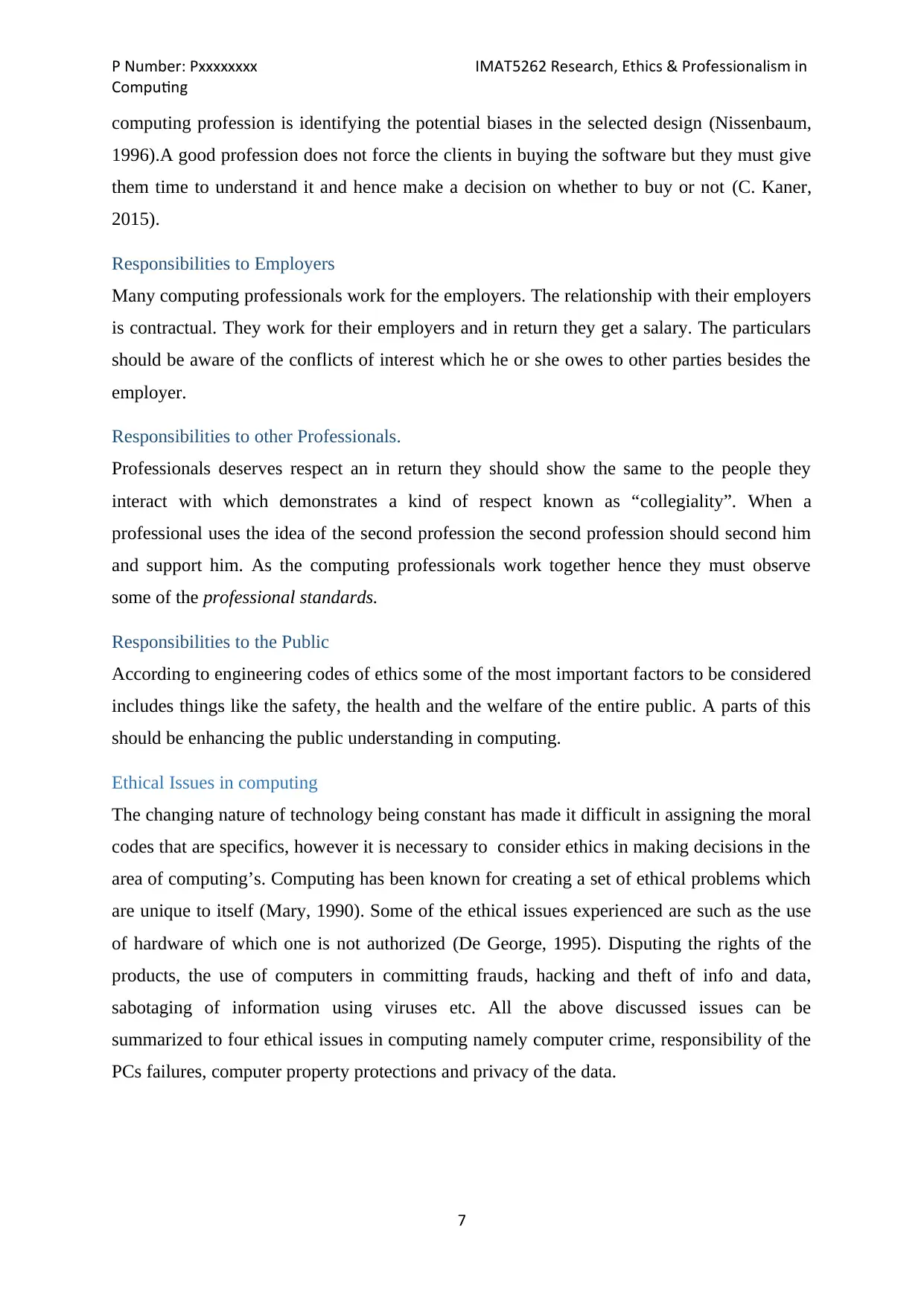
P Number: Pxxxxxxxx IMAT5262 Research, Ethics & Professionalism in
Computing
computing profession is identifying the potential biases in the selected design (Nissenbaum,
1996).A good profession does not force the clients in buying the software but they must give
them time to understand it and hence make a decision on whether to buy or not (C. Kaner,
2015).
Responsibilities to Employers
Many computing professionals work for the employers. The relationship with their employers
is contractual. They work for their employers and in return they get a salary. The particulars
should be aware of the conflicts of interest which he or she owes to other parties besides the
employer.
Responsibilities to other Professionals.
Professionals deserves respect an in return they should show the same to the people they
interact with which demonstrates a kind of respect known as “collegiality”. When a
professional uses the idea of the second profession the second profession should second him
and support him. As the computing professionals work together hence they must observe
some of the professional standards.
Responsibilities to the Public
According to engineering codes of ethics some of the most important factors to be considered
includes things like the safety, the health and the welfare of the entire public. A parts of this
should be enhancing the public understanding in computing.
Ethical Issues in computing
The changing nature of technology being constant has made it difficult in assigning the moral
codes that are specifics, however it is necessary to consider ethics in making decisions in the
area of computing’s. Computing has been known for creating a set of ethical problems which
are unique to itself (Mary, 1990). Some of the ethical issues experienced are such as the use
of hardware of which one is not authorized (De George, 1995). Disputing the rights of the
products, the use of computers in committing frauds, hacking and theft of info and data,
sabotaging of information using viruses etc. All the above discussed issues can be
summarized to four ethical issues in computing namely computer crime, responsibility of the
PCs failures, computer property protections and privacy of the data.
7
Computing
computing profession is identifying the potential biases in the selected design (Nissenbaum,
1996).A good profession does not force the clients in buying the software but they must give
them time to understand it and hence make a decision on whether to buy or not (C. Kaner,
2015).
Responsibilities to Employers
Many computing professionals work for the employers. The relationship with their employers
is contractual. They work for their employers and in return they get a salary. The particulars
should be aware of the conflicts of interest which he or she owes to other parties besides the
employer.
Responsibilities to other Professionals.
Professionals deserves respect an in return they should show the same to the people they
interact with which demonstrates a kind of respect known as “collegiality”. When a
professional uses the idea of the second profession the second profession should second him
and support him. As the computing professionals work together hence they must observe
some of the professional standards.
Responsibilities to the Public
According to engineering codes of ethics some of the most important factors to be considered
includes things like the safety, the health and the welfare of the entire public. A parts of this
should be enhancing the public understanding in computing.
Ethical Issues in computing
The changing nature of technology being constant has made it difficult in assigning the moral
codes that are specifics, however it is necessary to consider ethics in making decisions in the
area of computing’s. Computing has been known for creating a set of ethical problems which
are unique to itself (Mary, 1990). Some of the ethical issues experienced are such as the use
of hardware of which one is not authorized (De George, 1995). Disputing the rights of the
products, the use of computers in committing frauds, hacking and theft of info and data,
sabotaging of information using viruses etc. All the above discussed issues can be
summarized to four ethical issues in computing namely computer crime, responsibility of the
PCs failures, computer property protections and privacy of the data.
7
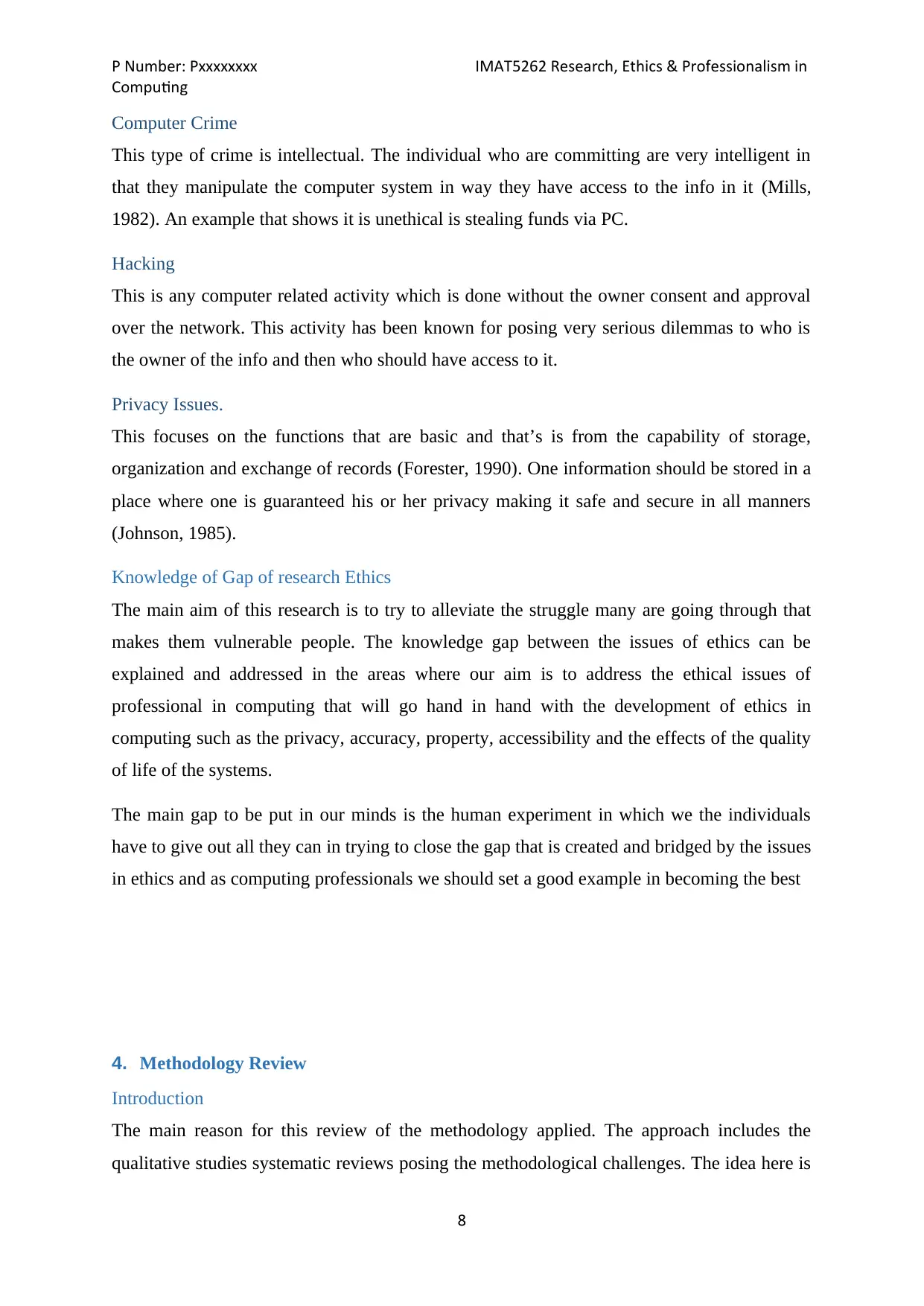
P Number: Pxxxxxxxx IMAT5262 Research, Ethics & Professionalism in
Computing
Computer Crime
This type of crime is intellectual. The individual who are committing are very intelligent in
that they manipulate the computer system in way they have access to the info in it (Mills,
1982). An example that shows it is unethical is stealing funds via PC.
Hacking
This is any computer related activity which is done without the owner consent and approval
over the network. This activity has been known for posing very serious dilemmas to who is
the owner of the info and then who should have access to it.
Privacy Issues.
This focuses on the functions that are basic and that’s is from the capability of storage,
organization and exchange of records (Forester, 1990). One information should be stored in a
place where one is guaranteed his or her privacy making it safe and secure in all manners
(Johnson, 1985).
Knowledge of Gap of research Ethics
The main aim of this research is to try to alleviate the struggle many are going through that
makes them vulnerable people. The knowledge gap between the issues of ethics can be
explained and addressed in the areas where our aim is to address the ethical issues of
professional in computing that will go hand in hand with the development of ethics in
computing such as the privacy, accuracy, property, accessibility and the effects of the quality
of life of the systems.
The main gap to be put in our minds is the human experiment in which we the individuals
have to give out all they can in trying to close the gap that is created and bridged by the issues
in ethics and as computing professionals we should set a good example in becoming the best
4. Methodology Review
Introduction
The main reason for this review of the methodology applied. The approach includes the
qualitative studies systematic reviews posing the methodological challenges. The idea here is
8
Computing
Computer Crime
This type of crime is intellectual. The individual who are committing are very intelligent in
that they manipulate the computer system in way they have access to the info in it (Mills,
1982). An example that shows it is unethical is stealing funds via PC.
Hacking
This is any computer related activity which is done without the owner consent and approval
over the network. This activity has been known for posing very serious dilemmas to who is
the owner of the info and then who should have access to it.
Privacy Issues.
This focuses on the functions that are basic and that’s is from the capability of storage,
organization and exchange of records (Forester, 1990). One information should be stored in a
place where one is guaranteed his or her privacy making it safe and secure in all manners
(Johnson, 1985).
Knowledge of Gap of research Ethics
The main aim of this research is to try to alleviate the struggle many are going through that
makes them vulnerable people. The knowledge gap between the issues of ethics can be
explained and addressed in the areas where our aim is to address the ethical issues of
professional in computing that will go hand in hand with the development of ethics in
computing such as the privacy, accuracy, property, accessibility and the effects of the quality
of life of the systems.
The main gap to be put in our minds is the human experiment in which we the individuals
have to give out all they can in trying to close the gap that is created and bridged by the issues
in ethics and as computing professionals we should set a good example in becoming the best
4. Methodology Review
Introduction
The main reason for this review of the methodology applied. The approach includes the
qualitative studies systematic reviews posing the methodological challenges. The idea here is
8
⊘ This is a preview!⊘
Do you want full access?
Subscribe today to unlock all pages.

Trusted by 1+ million students worldwide
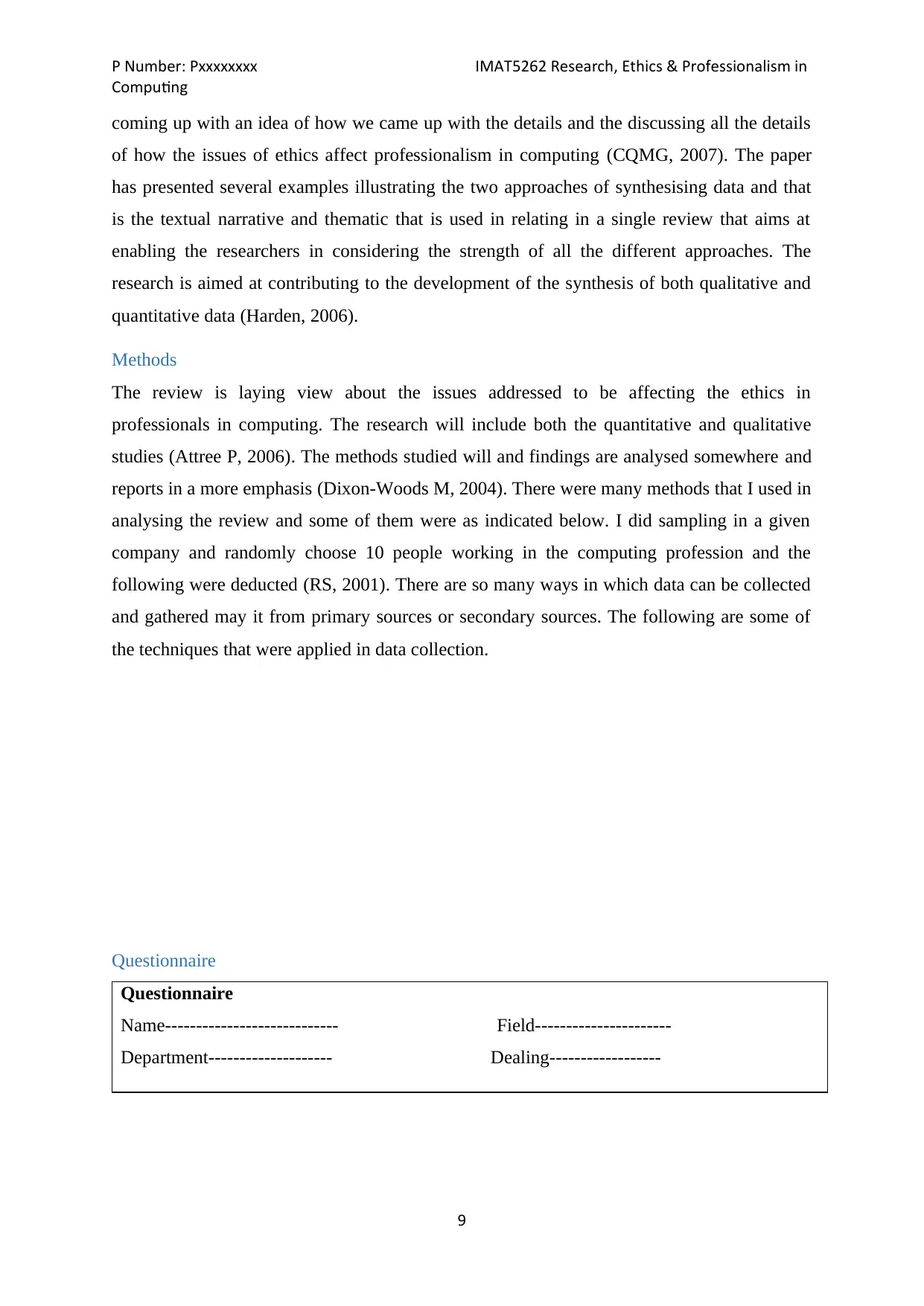
P Number: Pxxxxxxxx IMAT5262 Research, Ethics & Professionalism in
Computing
coming up with an idea of how we came up with the details and the discussing all the details
of how the issues of ethics affect professionalism in computing (CQMG, 2007). The paper
has presented several examples illustrating the two approaches of synthesising data and that
is the textual narrative and thematic that is used in relating in a single review that aims at
enabling the researchers in considering the strength of all the different approaches. The
research is aimed at contributing to the development of the synthesis of both qualitative and
quantitative data (Harden, 2006).
Methods
The review is laying view about the issues addressed to be affecting the ethics in
professionals in computing. The research will include both the quantitative and qualitative
studies (Attree P, 2006). The methods studied will and findings are analysed somewhere and
reports in a more emphasis (Dixon-Woods M, 2004). There were many methods that I used in
analysing the review and some of them were as indicated below. I did sampling in a given
company and randomly choose 10 people working in the computing profession and the
following were deducted (RS, 2001). There are so many ways in which data can be collected
and gathered may it from primary sources or secondary sources. The following are some of
the techniques that were applied in data collection.
Questionnaire
Questionnaire
Name---------------------------- Field----------------------
Department-------------------- Dealing------------------
9
Computing
coming up with an idea of how we came up with the details and the discussing all the details
of how the issues of ethics affect professionalism in computing (CQMG, 2007). The paper
has presented several examples illustrating the two approaches of synthesising data and that
is the textual narrative and thematic that is used in relating in a single review that aims at
enabling the researchers in considering the strength of all the different approaches. The
research is aimed at contributing to the development of the synthesis of both qualitative and
quantitative data (Harden, 2006).
Methods
The review is laying view about the issues addressed to be affecting the ethics in
professionals in computing. The research will include both the quantitative and qualitative
studies (Attree P, 2006). The methods studied will and findings are analysed somewhere and
reports in a more emphasis (Dixon-Woods M, 2004). There were many methods that I used in
analysing the review and some of them were as indicated below. I did sampling in a given
company and randomly choose 10 people working in the computing profession and the
following were deducted (RS, 2001). There are so many ways in which data can be collected
and gathered may it from primary sources or secondary sources. The following are some of
the techniques that were applied in data collection.
Questionnaire
Questionnaire
Name---------------------------- Field----------------------
Department-------------------- Dealing------------------
9
Paraphrase This Document
Need a fresh take? Get an instant paraphrase of this document with our AI Paraphraser
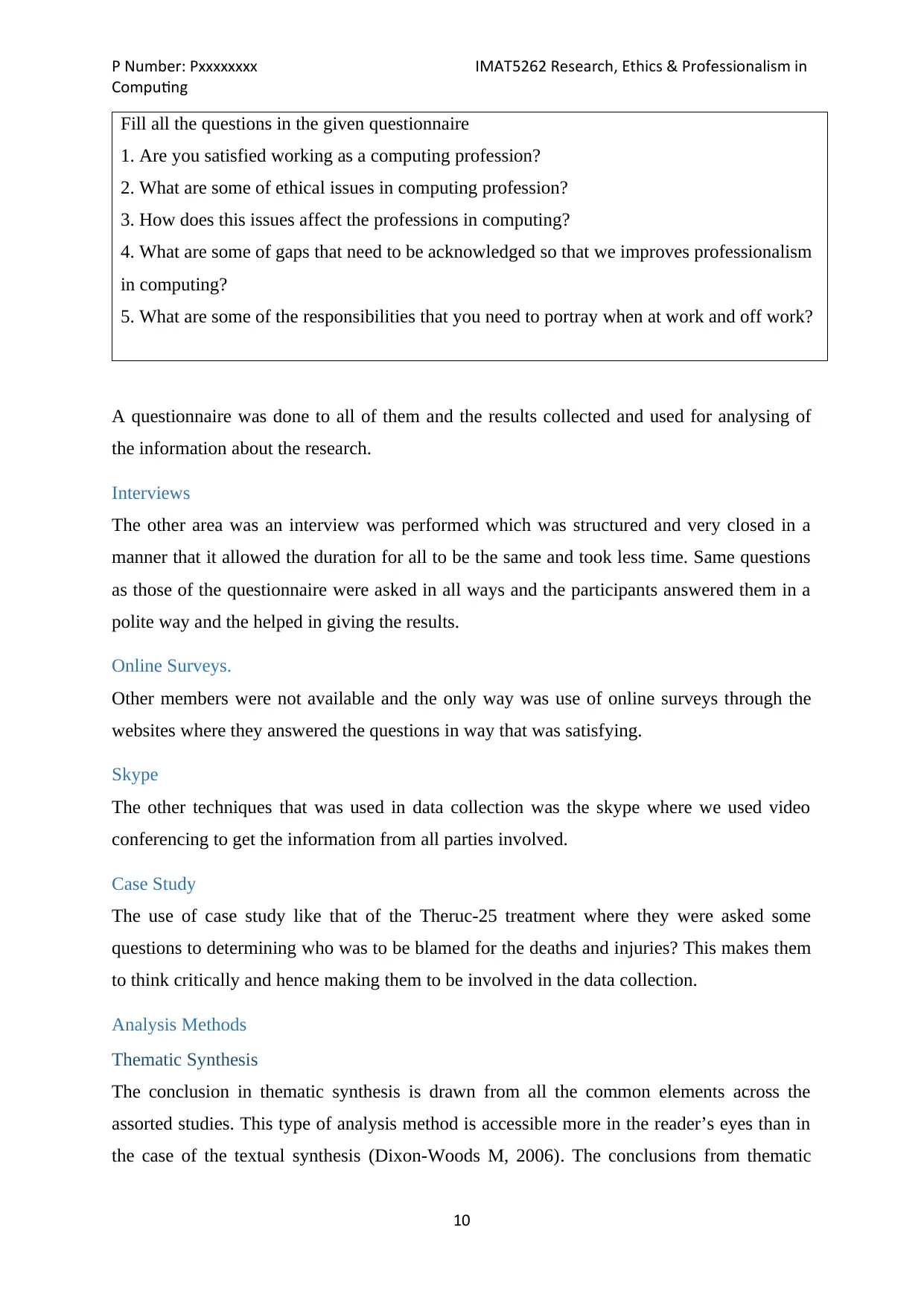
P Number: Pxxxxxxxx IMAT5262 Research, Ethics & Professionalism in
Computing
Fill all the questions in the given questionnaire
1. Are you satisfied working as a computing profession?
2. What are some of ethical issues in computing profession?
3. How does this issues affect the professions in computing?
4. What are some of gaps that need to be acknowledged so that we improves professionalism
in computing?
5. What are some of the responsibilities that you need to portray when at work and off work?
A questionnaire was done to all of them and the results collected and used for analysing of
the information about the research.
Interviews
The other area was an interview was performed which was structured and very closed in a
manner that it allowed the duration for all to be the same and took less time. Same questions
as those of the questionnaire were asked in all ways and the participants answered them in a
polite way and the helped in giving the results.
Online Surveys.
Other members were not available and the only way was use of online surveys through the
websites where they answered the questions in way that was satisfying.
Skype
The other techniques that was used in data collection was the skype where we used video
conferencing to get the information from all parties involved.
Case Study
The use of case study like that of the Theruc-25 treatment where they were asked some
questions to determining who was to be blamed for the deaths and injuries? This makes them
to think critically and hence making them to be involved in the data collection.
Analysis Methods
Thematic Synthesis
The conclusion in thematic synthesis is drawn from all the common elements across the
assorted studies. This type of analysis method is accessible more in the reader’s eyes than in
the case of the textual synthesis (Dixon-Woods M, 2006). The conclusions from thematic
10
Computing
Fill all the questions in the given questionnaire
1. Are you satisfied working as a computing profession?
2. What are some of ethical issues in computing profession?
3. How does this issues affect the professions in computing?
4. What are some of gaps that need to be acknowledged so that we improves professionalism
in computing?
5. What are some of the responsibilities that you need to portray when at work and off work?
A questionnaire was done to all of them and the results collected and used for analysing of
the information about the research.
Interviews
The other area was an interview was performed which was structured and very closed in a
manner that it allowed the duration for all to be the same and took less time. Same questions
as those of the questionnaire were asked in all ways and the participants answered them in a
polite way and the helped in giving the results.
Online Surveys.
Other members were not available and the only way was use of online surveys through the
websites where they answered the questions in way that was satisfying.
Skype
The other techniques that was used in data collection was the skype where we used video
conferencing to get the information from all parties involved.
Case Study
The use of case study like that of the Theruc-25 treatment where they were asked some
questions to determining who was to be blamed for the deaths and injuries? This makes them
to think critically and hence making them to be involved in the data collection.
Analysis Methods
Thematic Synthesis
The conclusion in thematic synthesis is drawn from all the common elements across the
assorted studies. This type of analysis method is accessible more in the reader’s eyes than in
the case of the textual synthesis (Dixon-Woods M, 2006). The conclusions from thematic
10
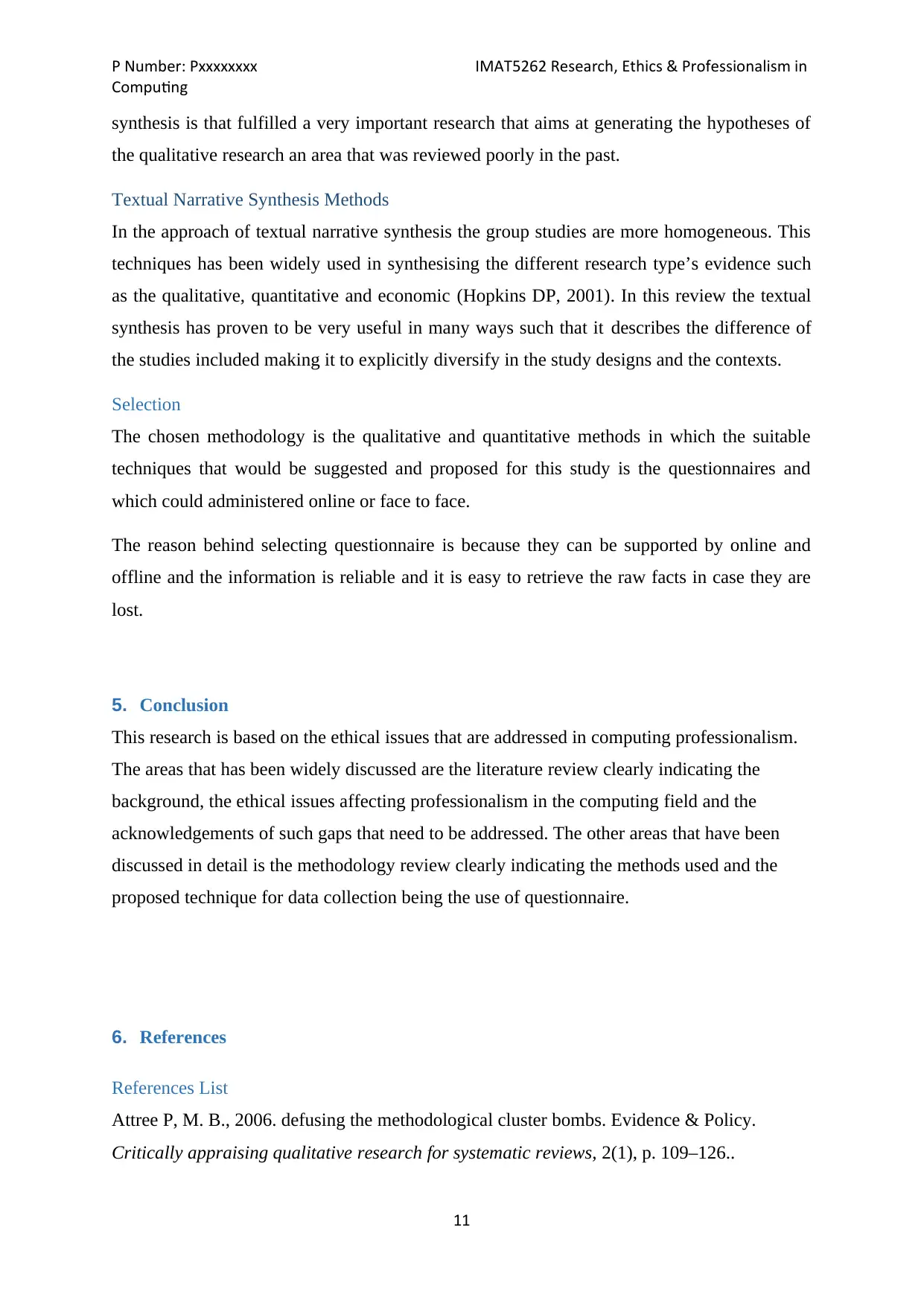
P Number: Pxxxxxxxx IMAT5262 Research, Ethics & Professionalism in
Computing
synthesis is that fulfilled a very important research that aims at generating the hypotheses of
the qualitative research an area that was reviewed poorly in the past.
Textual Narrative Synthesis Methods
In the approach of textual narrative synthesis the group studies are more homogeneous. This
techniques has been widely used in synthesising the different research type’s evidence such
as the qualitative, quantitative and economic (Hopkins DP, 2001). In this review the textual
synthesis has proven to be very useful in many ways such that it describes the difference of
the studies included making it to explicitly diversify in the study designs and the contexts.
Selection
The chosen methodology is the qualitative and quantitative methods in which the suitable
techniques that would be suggested and proposed for this study is the questionnaires and
which could administered online or face to face.
The reason behind selecting questionnaire is because they can be supported by online and
offline and the information is reliable and it is easy to retrieve the raw facts in case they are
lost.
5. Conclusion
This research is based on the ethical issues that are addressed in computing professionalism.
The areas that has been widely discussed are the literature review clearly indicating the
background, the ethical issues affecting professionalism in the computing field and the
acknowledgements of such gaps that need to be addressed. The other areas that have been
discussed in detail is the methodology review clearly indicating the methods used and the
proposed technique for data collection being the use of questionnaire.
6. References
References List
Attree P, M. B., 2006. defusing the methodological cluster bombs. Evidence & Policy.
Critically appraising qualitative research for systematic reviews, 2(1), p. 109–126..
11
Computing
synthesis is that fulfilled a very important research that aims at generating the hypotheses of
the qualitative research an area that was reviewed poorly in the past.
Textual Narrative Synthesis Methods
In the approach of textual narrative synthesis the group studies are more homogeneous. This
techniques has been widely used in synthesising the different research type’s evidence such
as the qualitative, quantitative and economic (Hopkins DP, 2001). In this review the textual
synthesis has proven to be very useful in many ways such that it describes the difference of
the studies included making it to explicitly diversify in the study designs and the contexts.
Selection
The chosen methodology is the qualitative and quantitative methods in which the suitable
techniques that would be suggested and proposed for this study is the questionnaires and
which could administered online or face to face.
The reason behind selecting questionnaire is because they can be supported by online and
offline and the information is reliable and it is easy to retrieve the raw facts in case they are
lost.
5. Conclusion
This research is based on the ethical issues that are addressed in computing professionalism.
The areas that has been widely discussed are the literature review clearly indicating the
background, the ethical issues affecting professionalism in the computing field and the
acknowledgements of such gaps that need to be addressed. The other areas that have been
discussed in detail is the methodology review clearly indicating the methods used and the
proposed technique for data collection being the use of questionnaire.
6. References
References List
Attree P, M. B., 2006. defusing the methodological cluster bombs. Evidence & Policy.
Critically appraising qualitative research for systematic reviews, 2(1), p. 109–126..
11
⊘ This is a preview!⊘
Do you want full access?
Subscribe today to unlock all pages.

Trusted by 1+ million students worldwide
1 out of 16
Related Documents
Your All-in-One AI-Powered Toolkit for Academic Success.
+13062052269
info@desklib.com
Available 24*7 on WhatsApp / Email
![[object Object]](/_next/static/media/star-bottom.7253800d.svg)
Unlock your academic potential
Copyright © 2020–2025 A2Z Services. All Rights Reserved. Developed and managed by ZUCOL.





